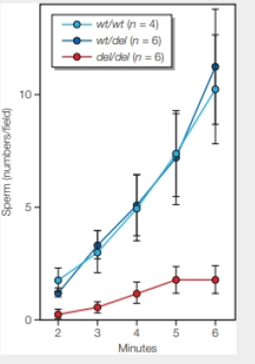
Stuck Sperm Cells lining the epididymis secrete a glycoprotein (beta-defensin) that coats sperm and facilitates their passage through cervical mucus. There are two common alleles for human beta-defensin: a wild-type allele (wt) and an allele with a deletion (del). To find out if this

FIGURE 41.12 Effect of beta defensin genotype on the ability of sperm to penetrate a gel that simulates cervical mucus. Sperm from 16 men was tested: 4wt/wt, 6wt/del, and 6 del/del.
Fresh sperm were placed on one side of the gel, and a video camera was focused on a region 2.75 mm into the gel. The number of sperm in this region was recorded at one-minute intervals for six minutes. Sperm numbers shown are averages. Bars indicate range.
After four minutes, how many sperm from men with a wild-type allele were in the camera's view an average?
To determine: The number of sperms from men with a wild-type allele were in the camera’s view on average.
Introduction: The epididymis is a part of the male reproductive system. Through the epididymis, the sperms travel from the testis to the vas deferens.
Explanation of Solution
An experiment was performed by researcher GC and colleagues about the effect of beta-defensin genotype on the ability of sperm to penetrate a gel that can stimulate cervical mucus. The cells of the epididymis secrete a beta-defensin protein that aids the sperms to pass through the cervical mucus of the female. The research team conducted an experiment to check whether the beta-defensin has any role in fertility. One allele of the gene coding for the beta-defensin was wild-type and the other allele was a mutated one. A barrier similar to cervical mucus was created in the form of a gel. The sperms were placed at one end of the gel and a video was recorded to check how many sperms with wild-type and mutated gene passed into the gel in the course of time.
A graph was plotted for time (minutes) on the X-axis and the number of sperms on the Y-axis for both the alleles of the beta-defensin gene.
Based on the values in the graph in Fig. 41.12, post four minutes, the men who have sperms with wild-type allele for beta defensin protein had six sperms within the camera view on average.
On average, six sperms were within the camera view after 4 minutes.
Want to see more full solutions like this?
Chapter 41 Solutions
Biology: The Unity and Diversity of Life (MindTap Course List)
Additional Science Textbook Solutions
Chemistry: Structure and Properties (2nd Edition)
Genetics: From Genes to Genomes
Campbell Essential Biology (7th Edition)
Microbiology Fundamentals: A Clinical Approach
Human Physiology: An Integrated Approach (8th Edition)
- What did the Cre-lox system used in the Kikuchi et al. 2010 heart regeneration experiment allow researchers to investigate? What was the purpose of the cmlc2 promoter? What is CreER and why was it used in this experiment? If constitutively active Cre was driven by the cmlc2 promoter, rather than an inducible CreER system, what color would you expect new cardiomyocytes in the regenerated area to be no matter what? Why?arrow_forwardWhat kind of organ size regulation is occurring when you graft multiple organs into a mouse and the graft weight stays the same?arrow_forwardWhat is the concept "calories consumed must equal calories burned" in regrads to nutrition?arrow_forward
- You intend to insert patched dominant negative DNA into the left half of the neural tube of a chick. 1) Which side of the neural tube would you put the positive electrode to ensure that the DNA ends up on the left side? 2) What would be the internal (within the embryo) control for this experiment? 3) How can you be sure that the electroporation method itself is not impacting the embryo? 4) What would you do to ensure that the electroporation is working? How can you tell?arrow_forwardDescribe a method to document the diffusion path and gradient of Sonic Hedgehog through the chicken embryo. If modifying the protein, what is one thing you have to consider in regards to maintaining the protein’s function?arrow_forwardThe following table is from Kumar et. al. Highly Selective Dopamine D3 Receptor (DR) Antagonists and Partial Agonists Based on Eticlopride and the D3R Crystal Structure: New Leads for Opioid Dependence Treatment. J. Med Chem 2016.arrow_forward
- The following figure is from Caterina et al. The capsaicin receptor: a heat activated ion channel in the pain pathway. Nature, 1997. Black boxes indicate capsaicin, white circles indicate resinferatoxin. You are a chef in a fancy new science-themed restaurant. You have a recipe that calls for 1 teaspoon of resinferatoxin, but you feel uncomfortable serving foods with "toxins" in them. How much capsaicin could you substitute instead?arrow_forwardWhat protein is necessary for packaging acetylcholine into synaptic vesicles?arrow_forward1. Match each vocabulary term to its best descriptor A. affinity B. efficacy C. inert D. mimic E. how drugs move through body F. how drugs bind Kd Bmax Agonist Antagonist Pharmacokinetics Pharmacodynamicsarrow_forward
 Human Biology (MindTap Course List)BiologyISBN:9781305112100Author:Cecie Starr, Beverly McMillanPublisher:Cengage Learning
Human Biology (MindTap Course List)BiologyISBN:9781305112100Author:Cecie Starr, Beverly McMillanPublisher:Cengage Learning
 Human Heredity: Principles and Issues (MindTap Co...BiologyISBN:9781305251052Author:Michael CummingsPublisher:Cengage Learning
Human Heredity: Principles and Issues (MindTap Co...BiologyISBN:9781305251052Author:Michael CummingsPublisher:Cengage Learning Biology (MindTap Course List)BiologyISBN:9781337392938Author:Eldra Solomon, Charles Martin, Diana W. Martin, Linda R. BergPublisher:Cengage Learning
Biology (MindTap Course List)BiologyISBN:9781337392938Author:Eldra Solomon, Charles Martin, Diana W. Martin, Linda R. BergPublisher:Cengage Learning Biology: The Unity and Diversity of Life (MindTap...BiologyISBN:9781305073951Author:Cecie Starr, Ralph Taggart, Christine Evers, Lisa StarrPublisher:Cengage Learning
Biology: The Unity and Diversity of Life (MindTap...BiologyISBN:9781305073951Author:Cecie Starr, Ralph Taggart, Christine Evers, Lisa StarrPublisher:Cengage Learning Concepts of BiologyBiologyISBN:9781938168116Author:Samantha Fowler, Rebecca Roush, James WisePublisher:OpenStax College
Concepts of BiologyBiologyISBN:9781938168116Author:Samantha Fowler, Rebecca Roush, James WisePublisher:OpenStax College





